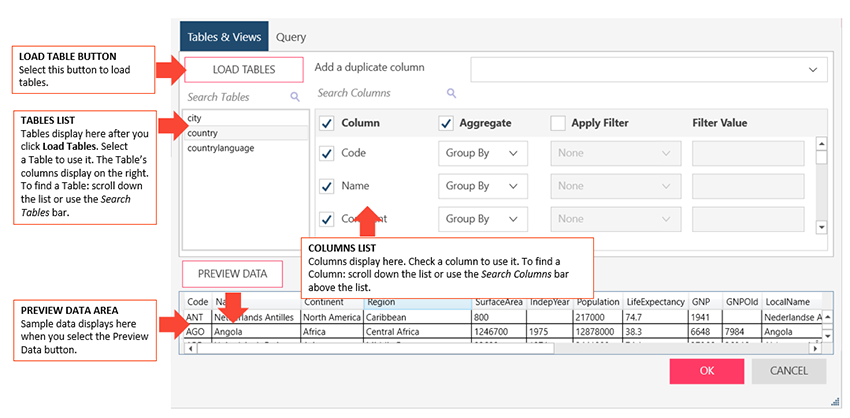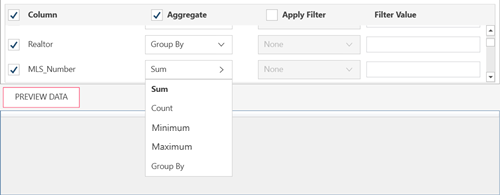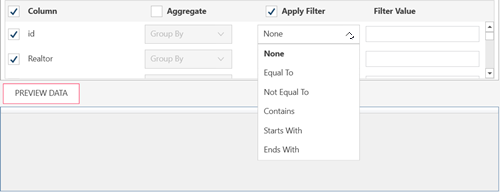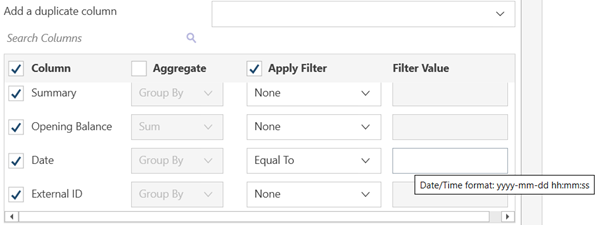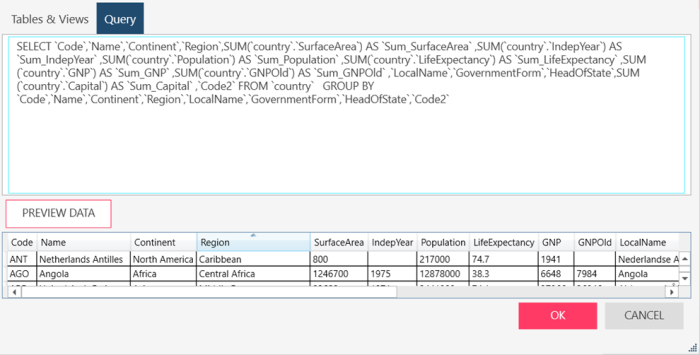Connector Dialog for Google Sheets
NOTE: The Google Sheets API only supports spreadsheets created within Google Sheets itself and does not support Excel files imported into the system.
The Google Sheets connector dialog includes the following fields and settings:
|
Field |
Description |
|
Connection |
|
|
Authentication Method |
The authentication method to be used during the course of the session. Select the method from the drop-down list:
|
|
Key File Path |
The path to a file that contains your service account keys. This setting is required if you select Service Account as the Authentication Method. Enter the path to the Service Account key file (in JSON format) containing the required credentials in the field provided. You can use the Browse |
|
Client ID |
The client ID key for your application when authenticating to REST endpoints with OAuth 2.0 enabled NOTE: In some cases, the value of this option is the same as your user name or authenticating address. In others, this value is supplied with your Client Secret. If you experience and authentication error, verify that you are using the correct value. |
|
Client Secret |
The client secret for your application when authenticating to REST endpoints with OAuth 2.0 enabled. IMPORTANT: The client secret is a confidential value used to authenticate the application to the service. To prevent unauthorized access, this value must be securely maintained. |
|
Scope |
A space-delimited list of OAuth scopes that limit the permissions granted by an access token at the time of connection The default values are: https://www.googleapis.com/auth/spreadsheets https://www.googleapis.com/auth/drive https://www.googleapis.com/auth/drive.file https://www.googleapis.com/auth/drive.readonly |
|
FileQuery |
The query string to filter the files to return. To search for a specific set of files or folders, use the query string q field with the files.list method to filter the files to return by combining one or more search terms. A query string contains the following three parts: query_term operator values Where:
Example: The following query string filters the search to only return folders by setting the MIME type: Refer to this page for more details. |
|
Range Column Start |
The start column number of the range. This is a required setting. |
|
Range Column End |
The end column number of the range. This is a required setting. |
|
Range Row Start |
The start row number of the range. If no value specified, row start will be set to 0. This is an optional setting. |
|
Range Row End |
The end row number of the range. If no value specified, row start will be set to 1000. This is an optional setting. |
|
First Row Is Headers |
A setting that, when set to True, converts the first row in the sheet to a column header. The default value is True. |
|
Reset |
A setting that, when set to True resets the session. The default value is False. |
|
Application Name |
The name of the application. The default value is Monarch Google Sheets. |
|
Tables & Views |
|
|
Tables & Views |
Allows you to load, and then select, the tables from your database by manually selecting from a list.
To load tables and views via search and select:
Note: If you wish to add a duplicate column, select this column from the Add a duplicate column drop-down list provided.
To select a column: Check the boxes beside the columns you want to use. If you want to use all columns, check the Column box on the header.
To aggregate columns: If the data returned are to be aggregated, check the Aggregate box on the header, then select the aggregation method you want to use for each column.
The following aggregation methods are possible for each data type:
To filter columns: If the data returned are to be filtered, check the Apply Filter on the header. Then, for each column, select a filter method from the filter drop down and then enter the filter value in the Filter Value box.
Notes:
|
|
Preview Data |
Click to fetch data using the credentials and criteria you have specified. This allows you to confirm your connection, ensure you have connected to the correct table, check your query, and verify the information that will be loaded. Notes:
|
|
Query |
|
|
Query |
Allows you to load, and then select, the tables from your database by entering a SQL Statement. If you already selected Tables and Views, this box is updated to show the corresponding SELECT * FROM TABLE query.
If you want to define the query, enter the SELECT, EXEC, and/or WITH statements to execute. Notes:
|
|
Preview Data |
Click to fetch data using the credentials and criteria you have specified. This allows you to confirm your connection, ensure you have connected to the correct table, check your query, and verify the information that will be loaded. Notes:
|
|
OK/CANCEL |
Select OK to establish the connection and fetch data or Cancel to close the dialog. The state of the OK and PREVIEW buttons provides a handy status about the state of your connection:
|
Notes:
-
Optional Fields. Other fields are optional but you may need to consult your data source administrator for other field values you need to enter to connect.
-
Connection Strings that Exceed 1020 characters. For Connection Strings that exceed 1020 characters, a File DSN is temporarily created. Refer to this page for details on the implementation.
-
Support for Short Names: Progress short names are supported by this release of Data Prep Studio, specifically in the Other Connection Options field. Refer to this page for details on the implementation.
© 2025 Altair Engineering Inc. All Rights Reserved.
 button to launch the Open dialog and locate this file.
button to launch the Open dialog and locate this file.